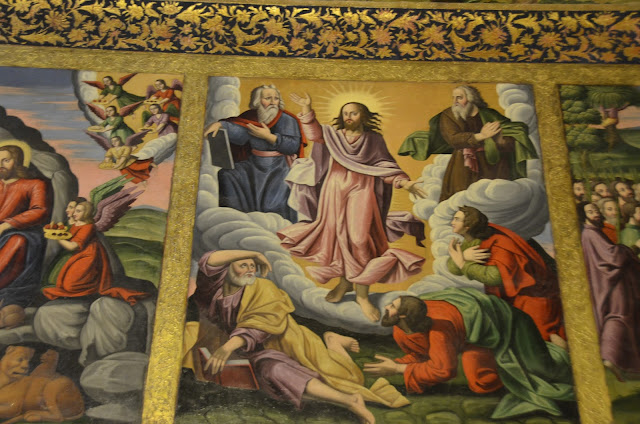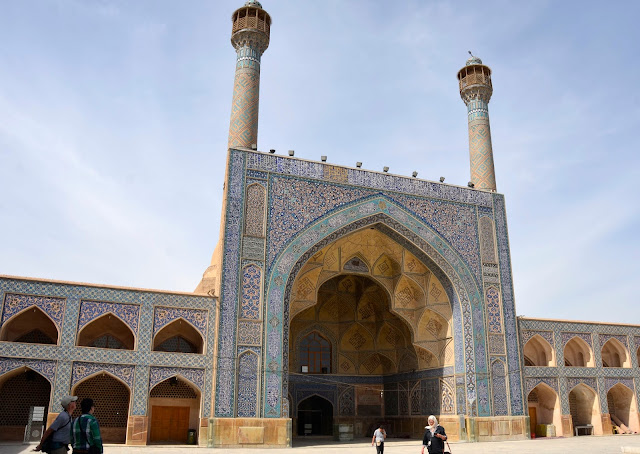The Armenian quarter is the oldest section of Esfahan.
In 1603 the Shah ordered resettlement of Armenian families who were allowed
freedom of worship. In 1915 the Turkish
Ottoman government exterminated one and half million Armenians or deported them
to Syria, Lebanon or Iran. The current Turkish government denies their
involvement in this atrocity. My guidebook tells me that the Armenian community
in Esfahan has shrunk from around 100,000 in the 1960’s to around 7,000 at the
present time. While Amin tells me there is a high degree of religious tolerance
in Esfahan and that the Christians, Muslims and Jews live together without
conflict, I wonder why the Armenian numbers have dropped so markedly.
 The beautiful Armenian
Christian church we view has bright colored panels retelling the tortures faced
by early Armenian Christians. It is a mixture of Christian and Islamic
architecture. Nearby is a museum that
shows graphic pictures of the Armenian genocide and it is heartbreaking for all
of us. With such pictures and documented evidence how could the Turkish
government not apologize?
The beautiful Armenian
Christian church we view has bright colored panels retelling the tortures faced
by early Armenian Christians. It is a mixture of Christian and Islamic
architecture. Nearby is a museum that
shows graphic pictures of the Armenian genocide and it is heartbreaking for all
of us. With such pictures and documented evidence how could the Turkish
government not apologize?
 The beautiful Armenian
Christian church we view has bright colored panels retelling the tortures faced
by early Armenian Christians. It is a mixture of Christian and Islamic
architecture. Nearby is a museum that
shows graphic pictures of the Armenian genocide and it is heartbreaking for all
of us. With such pictures and documented evidence how could the Turkish
government not apologize?
The beautiful Armenian
Christian church we view has bright colored panels retelling the tortures faced
by early Armenian Christians. It is a mixture of Christian and Islamic
architecture. Nearby is a museum that
shows graphic pictures of the Armenian genocide and it is heartbreaking for all
of us. With such pictures and documented evidence how could the Turkish
government not apologize? |
Paintings in Armenian Church 
Chehel Sotun 40 Column Palace
|

 |
| Roof of 40 Column Palace |
 |
| Inside 40 Column Palace |
We view a 17th century painting of an old man who died while his much younger wife is forced to kill herself. The picture shows her being given opium to drink and then required to walk into a burning fire.
Amin tells us that 40 is a holy number because 40 days after someone’s death there is another funeral or remembrance. He reminds us of Ali Babi and the 40 thieves and tells us a story of a king who killed or blinded his children so they wouldn’t kill him (1722). With one remaining child this King fed him opium so he would be a passive and calm ruler. I am not sure I understand the moral message of this story or why Amin is telling us this. I wonder when they enacted a law to prevent child abuse? We view a 17th century painting of an old man who died while his much younger wife is forced to kill herself. The picture shows her being given opium to drink and then required to commit suicide by walking into a burning fire.
 |
| Close Up of Picture Below Center |
 |

In a small and beautiful section of this place we see paintings of semi-nude women with lovers, dancing and drinking wine, which was forbidden in public but painted to reflect an interior life. Notice the picture of the naked chest in picture below.
 |
| Bare-chested woman |
Many of these paintings were covered with plaster by the Qjar dynasty but were later found and have had the plaster removed.
 |
| Removing plaster to reveal amazing paintings |
 |
Interesting that
1700 years ago the idea of painting was introduced by the Chinese so that many
early paintings show Chinese eyes rather than Iranian eyes. By the late 18th
century these paintings no longer had Chinese eyes.

Before going to the
mosques we pause for a tea break in a wonderful tea house next to the garden.
John loves all the carpets everywhere and thinks about putting them on our couches and walls at
home.
Esfahan’s Maydan-e Imam’s Two Mosques
We return to the enormous Imam Square and this time not for the bazaar but to visit two mosques. The Mashed-e Sheykh Lotfallah was a private mosque, therefore has no minarets and is thought to have been a mosque for the women of the royal harem. The construction of this amazing ceramic tile work and dome utilizing natural dyes began in 1600 and took one man and a couple of workers 18 years to complete. How patient people seem to have been at that time compared to today where speed seems to take precedence over beauty.
 |
The blue calligraphy on the tiles is the holy
version of the Koran. Robert Byron wrote a poem about the splendor of this
mosque comparing it to Versailles and St. Peters.

While it is rare to
find a signature on such tile work our guide points out the signature of this
artist. Apparently recognition of copyright has been a longterm issue.

We continue to walk through the public square to what Amin calls the Grand Mosque, built by Shah Abbas in 1612 for the prior Shah. Amin says it is the most completely designed mosque in Iran. Because the Shah was impatient about the progress being made he demanded that faster progress be made of the mosaic tile work used for the main entrance.

So we see one side of the entrance has intricate and individually placed mosaic tile designs while the other side uses the timesaving under glazed, painted tiles. So I guess some people of the 17th century were less patient.

 |
| Grand Mosque Dome |

This mosque has managed to survive several major earthquakes because of the wooden pieces put between bricks and a layer of lead added to the columns to absorb shakes. Finally Amin shows us an atypical Islamic set of tiles, which have animal and bird paintings, and tree of life not shown on any of the other tiles.
Amin believes this different style indicates the Armenian influence although this has not been documented. I think this mosque is the most amazing
mosque I have ever seen.
John tells Amin he wants to see as many mosques as
possible as he loves them. I am hoping he is developing a new addiction from carpets... but perhaps he wants to take his carpets to sit on these in mosques.
Mashed-e Jame Ancient Mosque
Now I find I am wrong about assessing mosque
beauty in terms of the façade and glitz of the colored tiles. In the next
mosque I discover the real beauty is all
about the brickwork. On our last day in Esfahan we go back to the Armenian
district to visit the UNESCO-listed Masjed-e
Jame, Ancient Mosque. It is said
to be the oldest mosque in Iran, dating back to the 10th century
where a small Arab style mosque was first built on the remains of a Zoroastrian
fire temple. We enter a huge domed
chamber that is entirely built of brickwork including the pillars and dome. Amin
explains how the 4-sided square walls are made into corners that support a
dome.
After viewing this
mosque we walk down a lovely authentic looking road and end up at a shrine, Harun-e Vilayet built in 1513.
At the
entrance we see two huge ceramic tiled murals of the faces of Khomeini and the
present spiritual leader, Ayatollah Khomeini.
Another tiled mural is of two men who lost their lives in a bomb attack on the Tehran headquarters of the Islamic Revolutionary Party.

I feel pulled back from the 10th century into the present world and am sad to have left that feeling of simple beauty and peacefulness.
 |
| Large Koran |
































No comments:
Post a Comment